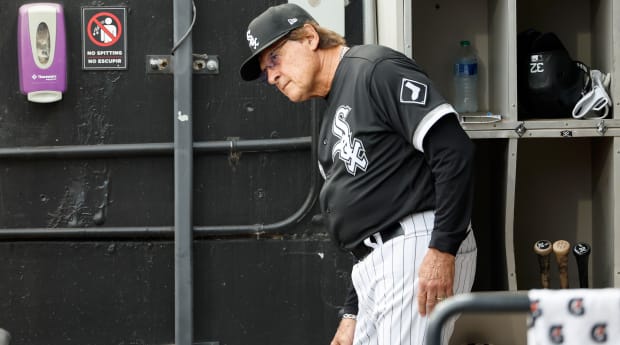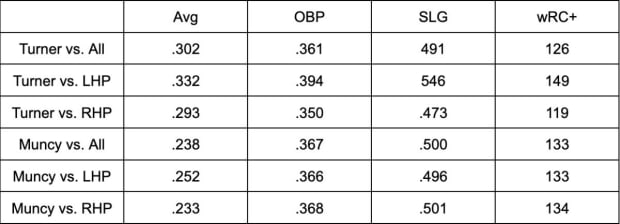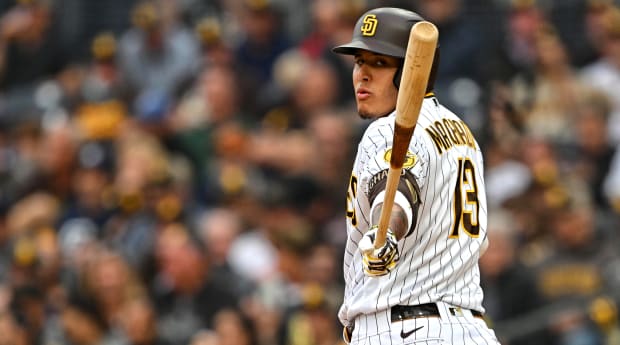Yesterday, in the Dodgers’ 11–9 win over the White Sox, Chicago manager Tony La Russa made the puzzling decision to intentionally walk Trea Turner on a 1–2 count to face Max Muncy.
Many of you probably know what happened, but let’s briefly run through the situation just in case before we dig into the thinking behind La Russa’s call and explain why, regardless of the result, it was the wrong move to make.
LA was up 6–5 in the top of the sixth inning at Guaranteed Rate Field yesterday. The White Sox had just squandered a 4–0 lead in the previous inning, when starter Dylan Cease surrendered six unearned runs. (La Russa let Cease throw 45 pitches in the fifth before he went to the bullpen, but we won’t get into that questionable decision here.)
With Gavin Lux on second and two outs, Freddie Freeman lined an RBI single to make it a two-run ballgame. La Russa called on left-handed reliever Bennett Sousa, who had a 6.50 ERA entering yesterday’s game, to face righty Trea Turner. Sousa quickly got ahead in the count, 0–2, before uncorking a wild pitch that allowed Freeman to advance to second. La Russa promptly signaled for the intentional walk. Muncy made him pay with a three-run home run to left field.

Kamil Krzaczynski/USA TODAY Sports
As Muncy stepped to the plate, White Sox TV broadcast duo Jason Benetti and Steve Stone questioned La Russa’s move in real time. Their dialogue was representative of what everyone watching was thinking.
Benetti: “Wait a second.”
Stone: “They’re gonna intentionally walk him.”
Benetti: “On 1–and–2?”
Stone: “Yup.”
Benetti: “Can you explain that to me?”
Stone: “I would think you don’t want Turner to do any more damage, and you want to take advantage of the lefty-lefty.”
Benetti: “Typically, at two strikes, the league batting average is quite low.”
Stone: “Oh, yeah. It is that.”
Benetti: “When was the last time you saw somebody intentionally walked on 1–and–2?”
Stone: “Doesn’t happen often.”
If it’s hard to tell in the transcript, the audio clip, which you can find here, makes clear that both Benetti and Stone are baffled by, and almost certainly disagree with, La Russa. Still, this exchange does a good job summing up the arguments for and against walking him.
La Russa loves his platoon advantages. He was one of the first managers to regularly use left-handed relief specialists to face one batter. More often than not across three decades, the left-on-left matchup has worked in La Russa’s favor.
“Turner with no strikes, one strike or two strikes is very dangerous against right[ies] and especially left[ies],” La Russa told reporters. “Now if maybe [right-handed hitting Will] Smith was hitting behind him it would have been a different thing. Muncy is there so it’s an easy call for me.”
La Russa is correct in his assessment that Turner is dangerous no matter the pitcher’s handedness, and that Turner is a better hitter against lefties. What he doesn’t say is that Muncy, too, does damage regardless of handedness, and that he, at least in terms of batting average, is a better hitter against lefties.
Since 2018 (entering yesterday’s game)

via FanGraphs
These splits, of course, don’t take into account the situation: runner in scoring position and two outs. Here’s how each player has fared in such situations since 2018.
Turner RISP Splits

via FanGraphs
Muncy RISP Splits

via FanGraphs
O.K., so there’s a lot of data here. Some of it could even be used to support La Russa’s decision. For example, consider only what the two players have done against lefties with runners in scoring position and two outs. In such situations, Turner, whose overall numbers are similar to peak Robin Yount, turns into Babe Ruth. Meanwhile, when Muncy, whose overall numbers are akin to Adam Dunn, faces lefthanders with two outs and runners in scoring position, he turns into 1977 Jimmy Wynn.
That said, La Russa’s logic falls apart when you consider some of the other information.
• The gap between the two players disappears when you look at the numbers against lefties with runners in scoring position, regardless of the number of outs: Muncy’s .977 OPS in those situations is the same as Mickey Mantle’s lifetime OPS, while Turner’s slash line is remarkable similar to the one Jimmie Foxx had in his career (.325/.428/.609). Once again, the sample sizes for Muncy and Turner are small (Muncy, 170 PA; Turner, 119 PA).
• Turner was hitting with only one man on base. After the intentional walk, Muncy came up with two on. The Dodgers have a better chance of scoring multiple runs with Muncy up and two men on than they do with Turner up and only Freeman on base. With two outs in the sixth inning, the priority should’ve been to prevent a multi-run hit, even if that meant risking a Turner RBI single.
• There were, and I cannot stress this enough, TWO STRIKES on Turner. It is extremely difficult to hit with two strikes. MLB hitters are batting .167 after they reach a 1–2 count. It’s true that Turner is a really good hitter, but like all hitters, he also gets worse when it’s a 1–2 count (.231/.280/.349).
Had the wild pitch happened to begin Turner’s plate appearance, or with Turner ahead in the count, the intentional walk would’ve been the right move because Turner is a much better hitter against left-handed pitching. But that wasn't the case here.
Ultimately, La Russa decided it was better to give Muncy three strikes to drive in at least one run than it was to give Turner one to do so just because of a platoon advantage that, realistically, doesn’t exist for a lefty against Muncy.
Have any questions for our team? Send a note to mlb@si.com.

John W. McDonough/Sports Illustrated
1. THE OPENER
“On the cusp of a personal milestone that puts him on the Hall of Fame highway, and thick in the very early MVP discussion, Manny Machado says he wants to avoid talking about one subject: Manny Machado.”
That’s how Tom Verducci begins this excellent profile of the Padres third baseman, who is no longer the brash young star type-cast as baseball’s villain. Instead, he’s having a career year and loving his new role as the veteran leader of a really good San Diego team.
Manny Machado Is Letting His Play Do the Talking by Tom Verducci
He is playing better than ever and is pushing his controversial past into the bin of an immature youth.
2. ICYMI
Let’s run through some of our other great SI baseball stories from this week.
How Concerned Should We Be About These Struggling All-Stars? by Nick Selbe
Salvador Perez and Nick Castellanos are among the talents underperforming in 2022. Will they turn things around?
Hot Seat Index: Which MLB Managers Could Be Fired Next? by Will Laws
Joe Girardi and Joe Maddon lost their jobs within the last week, and more skippers could soon be getting the boot.
Joe Maddon’s Firing Deepens Angels’ Era of Instability by Nick Selbe
Los Angeles’s knee-jerk response to a 12-game losing streak is more of the same impatience exhibited by owner Arte Moreno during his tenure.
‘That B---- Was Special’: Rickey Henderson’s Days As a Made Guy by Howard Bryant
In his new biography of the itinerant speedster, author Howard Bryant captures Henderson’s last cocksure days on the field—a final act like only Rickey could write.
The Absolute Improbability of Nick Castellanos’s Drives Into Deep Left Field by Jon Wertheim
Three successive seasons. Three earnest moments. Each broken up by a Nick Castellanos home run. Unlikely. Comically unlikely. The question: just how unlikely? We found out.
The Phillies Had No Choice but to Fire Joe Girardi by Tom Verducci
Trying to win without a reliable defense and bullpen is a losing formula. The veteran manager didn’t create those problems, but he did add to them.
3. WORTH NOTING from Matt Martell
The Rays won yesterday’s game at Tropicana Field, 2–1, to finish off a three-game sweep of the Cardinals. Yet the most notable part of the box score wasn’t the score or the names in the lineup, but the time of the game: 1 hour, 54 minutes. That is tied for the shortest nine-inning MLB game played over the last decade. The other 114-minute contest? A 4–2 White Sox win over the Blue Jays on July 6, 2015.
The most recent nine-inning game played in under an hour and 54 minutes was also played at Tropicana Field between the Rays and a team from Missouri. On Aug. 8, 2011, Tampa Bay beat the Royals, 4–0, in 113 minutes.
4. W2W4 from Nick Selbe
The matchup between the Dodgers and Giants is always appointment television, but this weekend’s set has an added layer of intrigue with the anticipated return of Clayton Kershaw from the injured list on Sunday. He’ll oppose Carlos Rodón, who’s posted a 6.00 ERA over his past five outings after a dominant start to the season.
Elsewhere, Saturday’s matchup between the Cardinals and Reds will pit veteran Adam Wainwright against rookie Hunter Greene. The two have a nearly 18-year age gap, which eclipses the 10.2 mph gap between the average velocity of their fastballs (Wainwright’s is 88.3, while Green’s is 98.5).
5. THE CLOSER from Matt Martell
The Phillies are 7–0 since they fired Joe Girardi last Friday. Entering the weekend, their playoff odds, which had dropped to 21.5% at the time of Girardi’s dismissal, are up to 36.3%, according to FanGraphs. Their problems haven’t disappeared. The defense is still abysmal and the bullpen remains unreliable. But the early returns from interim manager Rob Thomson are promising.







